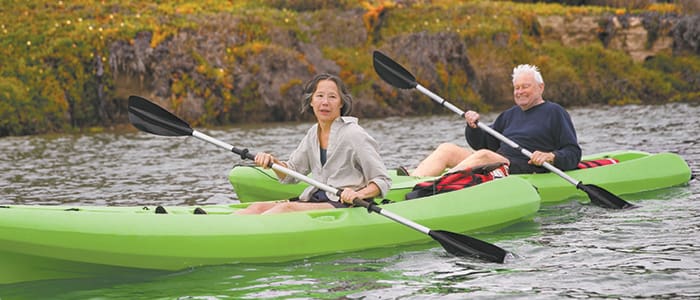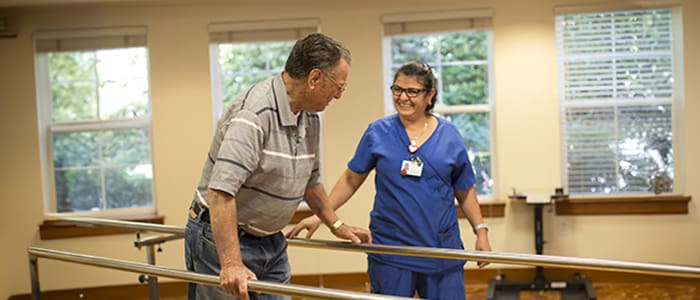December 10, 2019
A Year in Antarctica: Webster House Resident Recalls His Time in the Southern Hemisphere and Its Lasting Life Lessons
When Webster House resident Chet Frankenfield was growing up on the East Coast, he never dreamed that he would travel to Antarctica. His adventure started in 1956 when he was attending Officer Candidate School in Newport, Rhode Island and his commanding officer asked him if he would be interested in studying Aerology at the Postgraduate School in Monterey California. “All I heard was Monterey,” Frankenfield says; he didn’t even know what aerology was, but he jumped at the chance to go to California. He learned later that “it’s the Navy term for Meteorology” and when he got to Monterey he would be trained as a flight forecaster.
After he completed his yearlong training, Frankenfield moved back to the East Coast, where he was stationed in Patuxent River, Maryland. After a year in Maryland, a call went out for the next season in Antarctica. Frankenfield’s interest in Antarctica had been growing ever since he learned about the International Geophysical Year. As he notes, “it was one of the last places left on Earth that was not totally destroyed by tourists and was unexplored” and so he jumped at the chance.
The International Geophysical Year was a year and a half long worldwide study of the Earth that took place from July 1957 to December 1958. Most nations participated, building stations around the world, including in Antarctica. As Frankenfield notes, “this was the first time that they really included and had an extensive study of Antarctica,” including the effects of the massive ice cap on the rest of the world. His interest in Antarctica paid off and he was selected for the next season.
In Antarctica, Frankenfield had the opportunity to put his training to practical use, forecasting for flights between Christchurch, New Zealand and McMurdo station. Flight forecasting in Antarctica consisted of informing pilots of weather conditions, including wind speed and visibility, and telling them to turn back if conditions worsened. During the summer months, forecasts were also made for the helicopters and ski-equipped aircraft ferrying scientists, support personnel and supplies to research sites and outlying Antarctic stations.
After the runway, built on a frozen section of ice on McMurdo Sound, melted in early February, flights were discontinued. By mid-March, the last ship with the last of the summer personnel left; and the remaining 120 men began their seven months of isolation. Four of the months were in darkness, and the only personal communication with the rest of the world was by ham-radio.
Frankenfield maintained the McMurdo weather station 24 hours a day. He and his four-man wintering-over crew took weather readings and sent up weather balloons, which was quite an undertaking as it included blowing up the large balloon and tracking it so they could take hourly upper atmospheric readings.
He and his men decided on a strict twelve hours on, thirty-six hours off schedule, which Frankenfield says his men were not happy about at first but really appreciated by the end of the winter. Where other crews, such as some of the construction personnel who were tasked with rebuilding the runway come summer, had little to do over the winter, Frankenfield’s team’s steady schedule kept their minds working steadily with no time for boredom to set in.
Frankenfield worked the normal ten-hour seven day a week schedule. When he wasn’t working, he stayed busy by taking up a number of different hobbies from reading and playing chess to teaching math and learning oil painting. He even completed some, as he puts it, “fairly decent penguin pictures” though he gave them away to his fellow officers who wanted them for their kids.
McMurdo Station was only one mile from the abandoned hut of Robert Falcon Scott, the first British explorer to reach the pole, so Frankenfield explored the debris around the structure as the hut itself was filled with snow. He would look for any items from Scott’s stay and on one excursion, Frankenfield found two salt jars, which he kept as a souvenir for his sister. Years later when he visited the Canterbury Museum in Christchurch with his wife, he was surprised to find some of his salt jars on display.
But that wasn’t the biggest surprise from Frankenfield’s trip to Antarctica. About ten years ago, when he got a new iPad and tried Googling himself, he was surprised to learn that a glacier had been named after him without his knowledge. He wrote to the US Geological Survey and they confirmed that it was true, the Frankenfield Glacier was indeed named after him.
After his year in Antarctica and a short stint in New Zealand, Frankenfield had spent time aboard an icebreaker that was trying to penetrate the Bellingshausen Sea to reach a point of land that no ship had ever previously reached. Though the ship abandoned its goal when they received a distress signal from a Danish ship, they got close enough that Frankenfield and a couple of the crew were able to fly in and land. They set up a tiny weather station, which would inspire the Advisory Committee on Antarctic Names to name the glacier after him.
After returning from Antarctica, Frankenfield got a job in computer programming. He was just out of the military and had no experience in the computer industry but during his interview at a company in Sunnyvale, he noticed a book about Antarctic explorer Ernest Shackleton on his interviewer’s desk. “We sat there and talked about Antarctica for an hour,” Frankenfield says “and I left and I knew I had the job.” He pursued work in computers for the next thirty years until he retired in the 1990s.
The biggest lesson that Frankenfield took away from his time in Antarctica was how to live with himself and to keep himself entertained. He was told by a psychiatrist during a pre-expedition interview that he was “going to be bored as hell” and so he became determined to keep busy. Along with the hobbies that he took up over the year, he learned how to be comfortable with himself and to be content in any setting. It’s a skill that he holds onto to this day along with all of the memories of his year in Antarctica.






